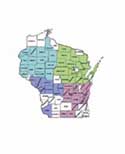By Katie Glick
 |
Click to enlarge |
When Chronic Wasting Disease (CWD) first threatened Wisconsin’s
deer population in 2002, policymakers and hunters alike immediately
recognized
the potential damage: curtailed hunting seasons, weakened economies
and health worries. But few people beyond the state’s food
pantries saw potential for a hidden crisis: starving families.
The Wisconsin Deer Donation Program (click on above map for locations),
funded by the Wisconsin Wildlife Damage Abatement and Claims Program
(WDACP),
encourages
hunters
with extra deer meat
to donate it to hungry people in Wisconsin. Over the last eight years, Deer Donation
and a similar program have funneled more than 750,000 pounds of venison into
state food pantries. However, the CWD scare may mean the program will end before
it hits the million-pound mark.
The program was founded in response to the Wisconsin Department of Natural Resources’ request
that hunters kill whitetail deer to reduce deer overpopulation. Yet hunters were
then hunting more meat than they could use. In 2000, the program put the extra
venison toward a positive cause: Wisconsin’s needy.
Several years earlier,
Hunt for the Hungry implemented a similar program, on which the Wisconsin Deer
Donation Program is based.
“Hunt for the Hungry was started in northeast Wisconsin in 1995 by a group
of hunters who felt that, although hunting was a sport, in the old days it was
simply
a way for a provider to feed his family and others in need of food,” says
Lee Dudek, Hunt for the Hungry’s volunteer coordinator. “Therefore,
it was their God-given duty to help others less fortunate than themselves by
donating their extra meat.”
In its first eight years, Hunt for the Hungry received 3,810 donated deer and
processed and distributed about 250,000 pounds of donated meat.
“Hunters began to see how good it felt to help others and because of this,
more
programs began popping up throughout the state,” Dudek says.
After seeing the success of Hunt for the Hungry and assessing the need to reduce
the number of whitetail deer, the WDACP began funding the Wisconsin Deer Donation
Program in 2000.
Hunt for the Hungry began using only private donations, but the WDACP expanded
the program by getting additional funding through the sale of extra antlerless
deer permits, according to Bryan Woodbury, WDACP wildlife damage specialist.
With major support from the Wisconsin Department of Natural Resources, United
States Department of Agriculture-Wildlife Services staff and Hunt for the Hungry,
more than 750,000 pounds of ground venison have been given to needy families
throughout the state in the past three years.
Despite the program’s good intentions, the discovery of CWD in just 1 to
2 percent of deer in southcentral Wisconsin caused the program to suffer and
may even force it into extinction.
Although CWD is a fatal disease that affects the nervous system of deer and has
never been shown to affect humans, a similar disease in cows called Bovine Spongiform
Encephalopathy (also known as Mad Cow Disease) has caused a fatal nervous system
disease in humans that have eaten tissue from the infected cattle.
Both Mad Cow
Disease and CWD are caused by abnormal protein called prions. These prions have
the ability to withstand extremely high temperatures, which the body normally
uses to kill such disease-causing protein. Because Mad Cow Disease proved fatal
to humans and contains a prion similar to CWD, it is impossible to say that CWD
will never cause human death. For this reason, many sponsors decided not to participate
in the 2002 program.
Second Harvest Food Bank stopped participating in the Deer Donation Program in
2002 because of CWD after providing 8,000 pounds of venison through the program
in 2001.
“What it really came down to is if you had any question about whether you
would
put this on your table at home, then we’re not going to offer it to others,” says
Bob Mohelnitzky, Second Harvest executive director. “It came down to that
kind of simple decision. If there’s any risk, we’re not going to
be involved in passing that risk.”
Because of the decrease in sponsors prompted by CWD, funding declined dramatically.
Therefore, a voluntary donation program was implemented in 2002, where hunters
could donate money to the Wisconsin Deer Donation Program when they bought their
hunter’s licenses to help increase funding.
“When purchasing a hunting license, hunters can now donate $1 or more to
support
the continuance of the Deer Donation Program,” says Dudek, who worries
that the program may be discontinued in 2004 because of insufficient funds.
While concerns about CWD are legitimate, important organizations are suffering
because of CWD’s negative impact on Wisconsin. Paul’s Pantry of Green
Bay, the largest food pantry in the United States, serves more than 150,000 needy
people each year with the help of programs like Hunt for the Hungry. Like other
pantries, Paul’s Pantry must purchase the meat they need to distribute
to their clients with limited funds. Because of this, they rely heavily on donations.
With the poor economy and job market, more people are depending on food pantries
and programs like the Deer Donation Program for assistance.
“We’re out here helping, we see the need … now more than ever,” Dudek
says. “The need is becoming greater and soon we may not have the funds
to manage the deer herd and provide the extra meat for the needy.”
With no other programs yet planned to compensate for the possible collapse of
the Deer Donation Program, many are questioning how Wisconsin will make up for
the food that may not be available to the needy anymore.
For more information, visit the following sites:
Hunt for the Hungry: This site provides more information on how
to get involved with the Hunt for the Hungry program.
Wisconsin
Department of Natural Resources: This site describes the Wisconsin
Deer Donation program.
|






